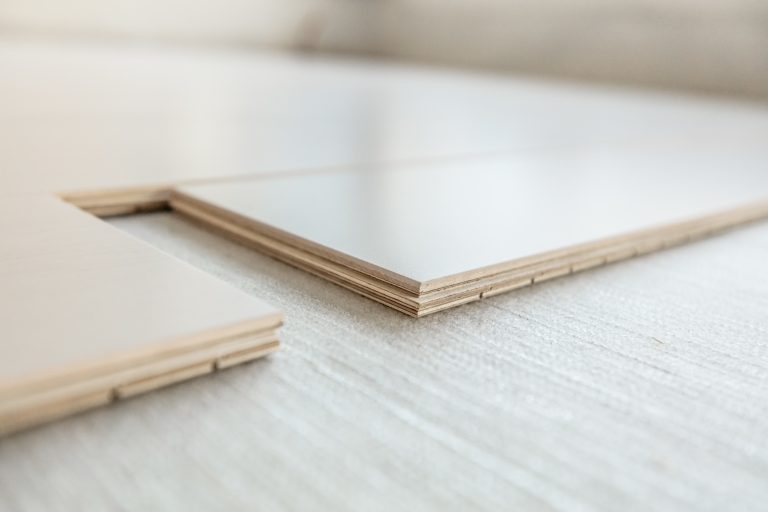Vinyl vs. Laminate Flooring: Which is Better for Your Home or Business?
When deciding on new flooring for your home or business, two popular options often stand out: vinyl and laminate. Both offer a range of styles, affordability, and durability, but how do you know which one is best for your space? Below, we’ll delve into the key differences between vinyl and laminate flooring, examining their pros and cons so you can make an informed decision.
Vinyl vs. Laminate: Key Differences
Before we dive into the advantages and disadvantages of each, let’s start by breaking down the key differences between vinyl and laminate flooring.
Material Composition:
- Vinyl flooring is made from synthetic materials. It typically consists of PVC (polyvinyl chloride) and is available in various forms such as luxury vinyl tiles (LVT) or vinyl planks. The entire structure is designed to be water-resistant and durable.
- Laminate flooring is composed of a wood-based core, usually made from high-density fiberboard (HDF), with a printed layer on top that mimics wood, stone, or tile. The uppermost layer is a protective resin that guards against scratches and wear.
Appearance and Feel:
- Vinyl is available in many styles and designs, mimicking the look of wood, tile, and stone, but the texture can sometimes feel less natural compared to laminate. Advances in technology have made vinyl’s visual quality more realistic, but it still tends to have a softer, more pliable feel underfoot.
- Laminate is highly regarded for its ability to realistically replicate the look and texture of natural wood. It often has a more convincing wood-like texture than vinyl, offering a more authentic aesthetic.
Durability and Resistance
Vinyl Flooring: One of vinyl’s most significant advantages is its waterproof nature. Whether you’re installing it in a kitchen, bathroom, or basement, vinyl flooring can withstand high humidity and moisture without warping or damage. This makes it an ideal choice for areas prone to spills or moisture.
Vinyl is also highly resistant to scratches and stains, making it a great option for households with pets or young children. The flexibility of the material ensures it’s comfortable underfoot, especially in spaces where you might spend long periods standing, like the kitchen.
Laminate Flooring: While laminate is water-resistant, it’s not entirely waterproof. Exposure to excessive moisture, especially over time, can lead to warping or swelling of the planks. However, laminate is typically more resistant to dents and scratches than vinyl, thanks to its tough wear layer. This makes it a good choice for high-traffic areas, but it’s generally better suited to rooms with lower moisture levels, such as living rooms, bedrooms, and hallways.
Flooring Installation Process
Both vinyl and laminate are relatively easy to install, especially if you opt for a floating floor system, which allows the planks to click together without glue or nails.
Vinyl: Vinyl planks are often designed with peel-and-stick or click-lock systems, making them easy to install for DIY enthusiasts. The flexible nature of vinyl flooring also means it can be laid over slightly uneven surfaces without issue. It’s generally easier to cut and handle compared to laminate, particularly in awkward spaces.
Laminate: Laminate flooring also uses a click-lock system, making installation straightforward. However, because it has a rigid core, laminate requires a more level subfloor to ensure a smooth installation. Any bumps or unevenness could lead to problems over time. Laminate shouldn’t be directly installed onto the floor and requires underlayment for added moisture resistance and sound absorption, whereas vinyl can sometimes be installed directly on the subfloor.
Vinyl and Laminate Cost Comparison
Vinyl: The cost of vinyl flooring can vary depending on whether you choose standard sheet vinyl or luxury vinyl planks (LVP), with LVP being more expensive. On average, vinyl tends to be slightly more affordable than laminate, especially for high-quality water-resistant products.
Laminate: Laminate flooring typically costs a bit more per square foot compared to vinyl but remains an affordable option. Premium laminate options with advanced designs or finishes might push the price higher, but overall, the difference in cost between vinyl and laminate is minimal.
Environmental Impact
Both laminate and vinyl flooring have environmental considerations.
Vinyl: Vinyl is a synthetic material, which means it’s made from non-renewable resources. However, some manufacturers offer eco-friendly options that use recycled materials. Disposal of vinyl can be problematic due to its chemical composition, as it doesn’t decompose naturally.
Laminate: Laminate is made from wood by-products, so it’s considered more environmentally friendly than vinyl. Some brands use sustainably sourced materials and produce laminate with minimal emissions. Additionally, because laminate has a longer lifespan and can be recycled, it’s often seen as a greener option.
Pros and Cons of Vinyl and Laminate Flooring
Vinyl Flooring Pros:
- 100% waterproof, ideal for moisture-prone areas
- Easy to install and maintain
- Soft and comfortable underfoot
- Available in a wide range of designs
Vinyl Flooring Cons:
- Can feel less natural than laminate
- May dent under heavy furniture
- Less eco-friendly due to synthetic materials
Laminate Flooring Pros:
- Offers a realistic wood-like appearance
- Resistant to scratches and wear
- Budget-friendly
- Easier to clean compared to real hardwood
Laminate Flooring Cons:
- Not completely waterproof, making it unsuitable for bathrooms or kitchens
- Requires a very level subfloor
- Less comfortable underfoot compared to vinyl
Which Should You Choose?
Ultimately, the choice between vinyl flooring and laminate flooring depends on where you plan to install it and your lifestyle needs. If you’re looking for flooring in moisture-prone areas like bathrooms, kitchens, or basements, vinyl is the clear winner due to its waterproof nature. On the other hand, for living spaces and areas with less moisture, laminate is a great option, especially if you want a natural wood-like look and feel.
Both flooring types have their advantages, and the best choice will depend on your specific needs, style preferences, and budget. At Get Floors, we are happy to help you navigate through these options and find the best flooring solution for your home or business. Contact our expert and friendly team today for personalised advice and a free consultation and quote.










